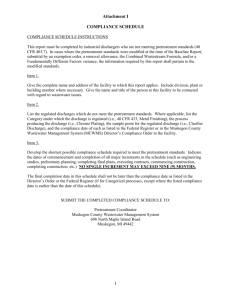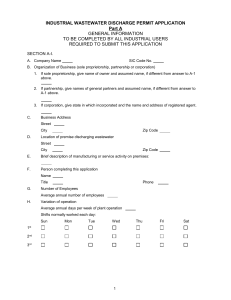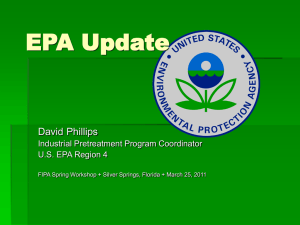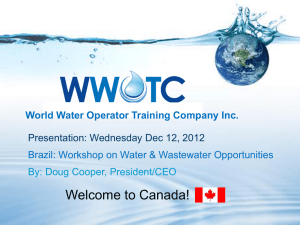Wastewater Pretreatment Standards for the Metal Finishing Industry
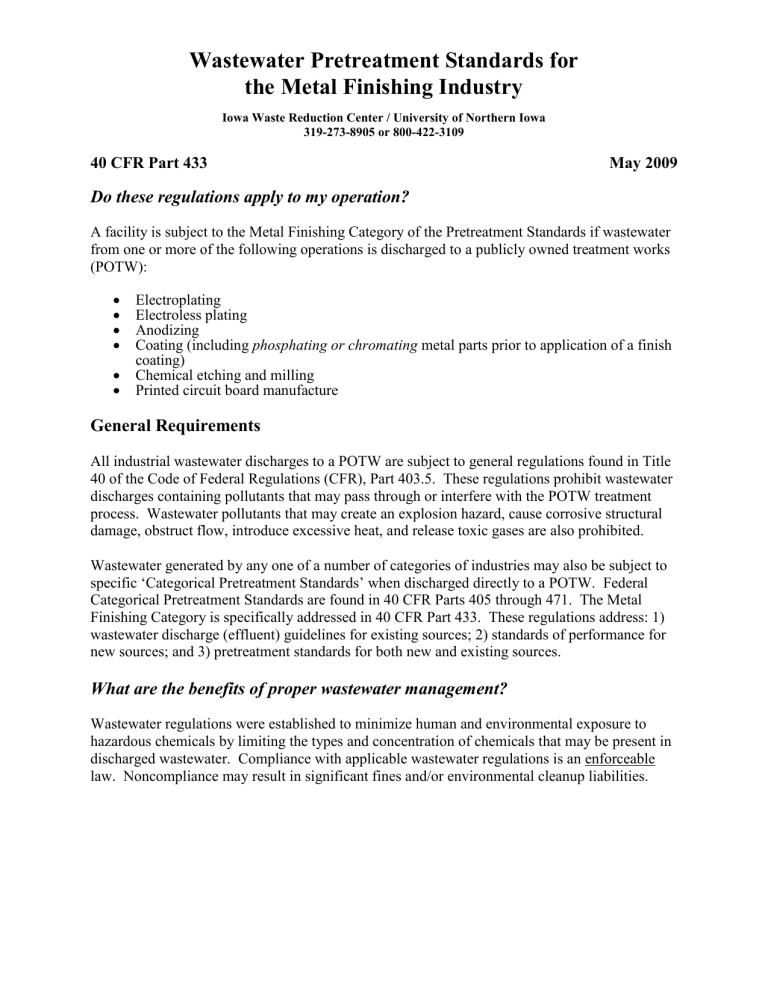
Wastewater Pretreatment Standards for the Metal Finishing Industry
Iowa Waste Reduction Center / University of Northern Iowa
319-273-8905 or 800-422-3109
40 CFR Part 433 May 2009
Do these regulations apply to my operation?
A facility is subject to the Metal Finishing Category of the Pretreatment Standards if wastewater from one or more of the following operations is discharged to a publicly owned treatment works
(POTW):
Electroplating
Electroless plating
Anodizing
Coating (including phosphating or chromating metal parts prior to application of a finish coating)
Chemical etching and milling
Printed circuit board manufacture
General Requirements
All industrial wastewater discharges to a POTW are subject to general regulations found in Title
40 of the Code of Federal Regulations (CFR), Part 403.5. These regulations prohibit wastewater discharges containing pollutants that may pass through or interfere with the POTW treatment process. Wastewater pollutants that may create an explosion hazard, cause corrosive structural damage, obstruct flow, introduce excessive heat, and release toxic gases are also prohibited.
Wastewater generated by any one of a number of categories of industries may also be subject to specific ‘Categorical Pretreatment Standards’ when discharged directly to a POTW. Federal
Categorical Pretreatment Standards are found in 40 CFR Parts 405 through 471. The Metal
Finishing Category is specifically addressed in 40 CFR Part 433. These regulations address: 1) wastewater discharge (effluent) guidelines for existing sources; 2) standards of performance for new sources; and 3) pretreatment standards for both new and existing sources.
What are the benefits of proper wastewater management?
Wastewater regulations were established to minimize human and environmental exposure to hazardous chemicals by limiting the types and concentration of chemicals that may be present in discharged wastewater. Compliance with applicable wastewater regulations is an enforceable law. Noncompliance may result in significant fines and/or environmental cleanup liabilities.
Facility Requirements
Record Keeping/Reports
Baseline Monitoring Reports
Facilities subject to the Metal Finishing Pretreatment Standards must prepare and submit a baseline monitoring report (BMR) to their ‘control authority.’ The control authority is: 1) the local POTW if it has an approved pretreatment program or 2) the Iowa Department of Natural
Resources. The BMR provides information on a facility’s current operations, its wastewater characteristics, and its compliance status with the pretreatment standard. The following information must be included in a BMR:
The name and address of the facility and its owners;
A list of all environmental control permits held by the facility;
A description of the operations conducted at the facility, including average production rates, Standard Industrial Classification (SIC) codes, and a schematic diagram of processes that discharge to the POTW;
Wastewater flow measurements from regulated discharges;
Identification of the Pretreatment Standards applicable to each regulated process and pollutant concentration/mass data for regulated parameters, including:
A statement certifying whether the facility is in or out of compliance with the applicable Pretreatment Standards; and
If the facility is not in compliance, a description and schedule of actions that will be implemented to achieve compliance.
More detailed information on the BMR format is available in 40 CFR 403.12(b) and (c). A
BMR was due in February 1984 for facilities in operation at that time. Facilities with regulated processes beginning after February 1984 must submit a BMR 90 days prior to the commencement of wastewater discharge.
Compliance Reports
In addition to the BMR, regulated facilities must comply with the following requirements:
A Report on Compliance (i.e., a 90-Day Compliance Report)
An initial compliance report must be submitted to the control authority within 90 days of the final compliance date of the standards or the date a new facility began discharge of a regulated wastewater. This report indicates whether the Metal Finishing Pretreatment
Standards are being met on a consistent basis. It includes information on the concentration of all regulated pollutants, average and maximum daily flow rates and, if not in compliance, what additional practices will be implemented to achieve compliance.
See 40 CFR 403.12(d).
Periodic Reports of Continued Compliance
A periodic compliance report must be submitted to the control authority semi-annually.
While the regulations indicate these reports should be submitted in June and December, the control authority may adjust these dates to meet specific needs. Each report includes information on pollutant concentrations, average and maximum daily flow rates, sampling/analytical methodology, and a certification statement indicating the methodology conforms with the regulations. See 40 CFR 403.12(e).
Notice of Slug Loading
A facility must immediately notify its POTW if any pollutant is released at a flow rate or concentration that will interfere with the POTW’s normal operation (i.e., the 40 CFR
403.5 prohibitions). See 40 CFR 403.12(f).
All wastewater records and monitoring data must be maintained on site and be available for inspection upon request. These records should be maintained for a period of at least of three years.
Monitoring Requirements
Regulated facilities that began operating prior to August 1982 must meet Pretreatment Standards for Existing Sources (PSES) while facilities beginning operation after August 1982 are subject to
Pretreatment Standards for New Sources (PSNS). PSES and PSNS Pretreatment standards are presented in Table 1. As shown, PSNS Pretreatment Standards are identical to those established for PSES with the exception of Cadmium.
The total toxic organics (TTO) category includes approximately 110 compounds such as benzene, tetrachloroethylene, toluene, trichloroethylene, PCB, etc. Initial TTO monitoring and reporting must be included as part of the BMR for TTO “which would reasonably be expected to be present” in the waste stream. The Control Authority may exclude subsequent TTO monitoring if a facility demonstrates TTO compliance in the BMR and it meets each of the following requirements:
The facility submits a solvent management plan to the control authority. The plan should include a list of the toxic organic compounds used at the facility, the method of disposal for these compounds (other than sewer discharge), and procedures for ensuring that toxic organics do not routinely spill or leak into the wastewater discharge. See 40 CFR
403.12(g), 40 CFR 433.12, and 40 CFR 433.16.
The facility provides the following certification statement in each periodic report.
Based on my inquiry of the person or persons directly responsible for managing compliance with the permit limitation [or pretreatment standard] for total toxic organics
(TTO), I certify that, to the best of my knowledge and belief, no dumping of concentrated toxic organics into the wastewaters has occurred since filing of the last discharge monitoring report. I further certify that his facility is implementing the toxic organic management plan submitted to the control authority.
Table 1 - PSES and PSNS Pretreatment Standards
Pollutant or Pollutant Property Single Day - Maximum
Milligrams per liter (mg/l)
Total Cadmium 0.69 (0.11
*
)
Total Chromium
Total Copper
2.77
3.38
Total Lead
Total Nickel
Total Silver
Total Zinc
Total Cyanide
0.69
3.98
0.43
2.61
1.20
Monthly Average - Maximum
Milligrams per liter (mg/l)
0.26 (0.07
1.71
2.07
0.43
2.38
0.24
1.48
0.65
*
)
Total Toxic Organics (TTO) 2.13 ..................
*
Note: PSNS Pretreatment Standards for cadmium are denoted by values in parentheses.
Wastewater discharge standards for pH, Oil & Grease, and TSS, will likely be established by the local POTW.
